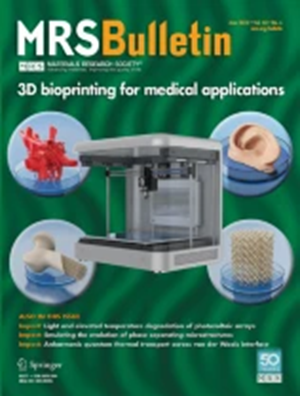Liquid metal serves as stretchable hermetic seal in soft electronics
IF 4.1
3区 材料科学
Q2 MATERIALS SCIENCE, MULTIDISCIPLINARY
引用次数: 0
Abstract
S electronics aims to revolutionize the architecture and design of conventional electronics that are rigid and fixed. Electronic devices that are flexible and elastic without losing their electrical and thermal conductivity properties, the integrity of the internal circuits, and the basic operating conditions are needed for many applications. Now, an international team of researchers reports in a recent issue of Science (https:// www. scien ce. org/ doi/ 10. 1126/ scien ce. ade73 41) that it is possible to incorporate liquid metal to protect and insulate the active zone of some flexible electronic devices without compromising the elastic properties. In general, the most easily deformable materials with lower Young’s modulus, such as elastomers, are highly permeable to ambient gases such as oxygen and water vapor. In addition, in hard electronics, a stiff architecture is chosen that favors the isolation of the circuits, cables, and electrodes so that they do not suffer damage due to reactive species that can affect the performance and operation of the equipment. Michael D. Dickey of North Carolina State University and colleagues take advantage of the physical properties of liquid gallium and its alloys—specifically eutectic gallium indium (EGaIn)— in lithium-ion batteries (LIBs) with a water-based electrolyte, in stretchable heat-transfer systems, and in wireless communication processes. The metallic nature of the material acts as a hermetic seal because metals normally serve as an impermeable barrier for many substances. As a fluid, liquid gallium is known to have little resistance to deformation and meets the main need for soft electronics. Dickey told MRS Bulletin, “There are only a few metals that are liquid at room temperature. Mercury is a liquid but it is toxic. We focus on gallium because it can be patterned into a film due to the native oxide that forms on the surface of the metal.” Dickey said that gallium, combined with other metals such as indium, tin, and zinc, form alloys with lower melting points. Other metals such as In and Sn could be used if higher temperatures are tolerated, he said. By introducing the seal prepared with liquid gallium, the battery achieved significant improvement in its retention capacity after 500 charge and discharge cycles; likewise, a higher thermal conductivity was obtained in the heat transfer, and the transmission of wireless signals through the seals was verified. “We have essentially created a stretchable metal container,” Dickey said. “Metal containers normally act like Faraday cages, which block RF and wireless communication. The ability for the container to transmit wireless signals would enable the encapsulation of electronic devices built from materials that are stretchable but prone to oxidation or degradation from water vapor.” The prospects for the future of soft electronics are promising. “I personally take inspiration from human tissue, which is completely soft yet capable of doing amazing things like sense, actuate, compute, and heal,” Dickey said. “The ability to mimic these properties can allow for electronics to be used in new ways.” Alessandro Romo-Gutiérrez

液态金属在软电子产品中用作可拉伸的密封密封
S电子旨在彻底改变刚性和固定的传统电子产品的结构和设计。许多应用都需要柔性和弹性的电子设备,而不会失去其导电性和导热性、内部电路的完整性以及基本操作条件。现在,一个国际研究小组在最近一期的《科学》杂志上发表了报告(https://www.Science.org/doi/10)。1126/科学。ade7341),在不损害弹性特性的情况下,可以结合液态金属来保护和隔离一些柔性电子设备的有源区。通常,杨氏模量较低的最容易变形的材料,如弹性体,对氧气和水蒸气等环境气体具有高度渗透性。此外,在硬电子产品中,选择了有利于隔离电路、电缆和电极的刚性结构,这样它们就不会因可能影响设备性能和操作的反应物质而受到损坏。北卡罗来纳州立大学的Michael D.Dickey及其同事利用液态镓及其合金的物理特性,特别是低共熔镓铟(EGaIn),在具有水性电解质的锂离子电池(LIBs)、可拉伸传热系统和无线通信过程中发挥作用。材料的金属性质起到了气密密封的作用,因为金属通常是许多物质的不可渗透屏障。作为一种流体,已知液态镓对变形的抵抗力很小,满足了对软电子产品的主要需求。Dickey告诉MRS Bulletin,“只有少数金属在室温下是液态的。汞是液态的,但它是有毒的。我们关注镓,因为金属表面形成的天然氧化物可以将其图案化成膜。”Dickey说,镓与铟、锡和锌等其他金属结合,形成熔点较低的合金。他说,如果能容忍更高的温度,也可以使用In和Sn等其他金属。通过引入用液态镓制备的密封件,该电池在500次充电和放电循环后的保持能力显著提高;同样,在热传递中获得了更高的热导率,并验证了无线信号通过密封件的传输。Dickey说:“我们基本上创造了一个可拉伸的金属容器。”。“金属容器通常像法拉第笼一样,阻挡射频和无线通信。容器传输无线信号的能力将使电子设备能够封装,这些设备由可拉伸但容易被水蒸气氧化或降解的材料制成。”软电子的未来前景很有希望。Dickey说:“我个人的灵感来自人类组织,它完全柔软,但能够做一些令人惊叹的事情,比如感知、启动、计算和治疗。”。“模拟这些特性的能力可以让电子产品以新的方式使用。”Alessandro Romo Gutiérrez
本文章由计算机程序翻译,如有差异,请以英文原文为准。
求助全文
约1分钟内获得全文
求助全文
来源期刊

Mrs Bulletin
工程技术-材料科学:综合
CiteScore
7.40
自引率
2.00%
发文量
193
审稿时长
4-8 weeks
期刊介绍:
MRS Bulletin is one of the most widely recognized and highly respected publications in advanced materials research. Each month, the Bulletin provides a comprehensive overview of a specific materials theme, along with industry and policy developments, and MRS and materials-community news and events. Written by leading experts, the overview articles are useful references for specialists, but are also presented at a level understandable to a broad scientific audience.
 求助内容:
求助内容: 应助结果提醒方式:
应助结果提醒方式:


